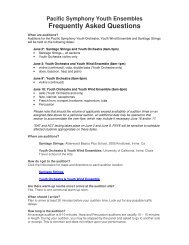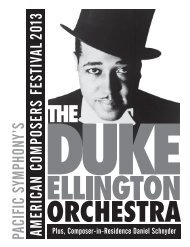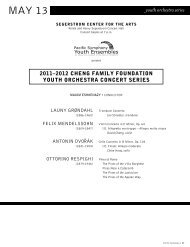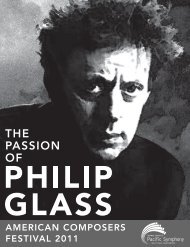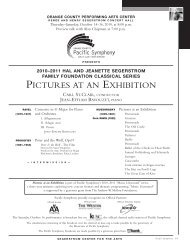Program Notes - Pacific Symphony
Program Notes - Pacific Symphony
Program Notes - Pacific Symphony
You also want an ePaper? Increase the reach of your titles
YUMPU automatically turns print PDFs into web optimized ePapers that Google loves.
NOTES<br />
T<br />
onight’s concert celebrates the centenary of Igor Stravinsky’s<br />
The Rite of Spring (Le Sacre du Printemps), premiered<br />
May 29, 1913, at Paris’s Théâtre des Champs-Élysées, with<br />
Pierre Monteux conducting and choreography by Vaslav Nijinsky –<br />
a premiere famous for the riot it provoked. So deafening were the<br />
jeers and catcalls that the dancers could not hear the music: Nijinsky<br />
frantically supervised standing on a backstage chair. That is: the riot<br />
was more a response to what was seen – a ritualized style of “ballet”<br />
as remote from tutus and swans as Stravinsky’s score (had it been<br />
audible) was from Sleeping Beauty or Giselle. It was not until the<br />
following April that Monteux led a concert performance of The Rite<br />
of Spring – and it is as a 35-minute concert piece, sans dance, that<br />
The Rite became a seminal 20th-century masterpiece.<br />
The music’s fascination is multi-faceted. It wears two faces,<br />
diametrically opposed. Let’s call them “Dionysian” and “Apollonian.”<br />
Considered as Dionysian music, The Rite of Spring is visceral, raw,<br />
brutal. Stravinsky called it “scenes from pagan Russia,” the last<br />
being a barbaric Sacrificial Dance depicting a virgin dancing herself<br />
to death. It is pertinent that Nicolas Roerich, the distinguished<br />
Russian painter who contributed to the scenario as well as designing<br />
backcloths and costumes for the first performance, was also an<br />
archeologist with specialized knowledge of the ancient Slavs. Roerich<br />
summarized “the ballet of The Rite of Spring” as “scenes of earthly<br />
joy and celestial triumph as understood by the Slavs.” Stravinsky<br />
once wrote that his first inspiration was envisioning “a solemn pagan<br />
rite: wise elders, seated in a circle, watching a young girl dance<br />
herself to death. They were sacrificing her to propitiate the god of<br />
spring.” A violent primal ceremony.<br />
The Apollonian face of The Rite of Spring, by comparison, is nonviolent:<br />
a pathbreaking compositional study in dissonant harmony<br />
and – especially – complex rhythm. While in recent decades the<br />
conductor/composer Pierre Boulez has influentially propagated this<br />
“objective” reading of the score (buttressed by a formal musical<br />
analysis anticipating the 12-tone procedures of Arnold Schoenberg), it<br />
was Stravinsky himself, in his post-World War I Parisian incarnation,<br />
who initially absorbed The Rite of Spring within a musical aesthetic<br />
promoting order and discipline. In exile from his beloved Russia,<br />
Stravinsky had reinvented himself as an Apollonian Francophile,<br />
rejecting Russian “anarchy” in favor of prevalent French ideals of<br />
aesthetic perfection. In his Poetics of Music, delivered at Harvard in<br />
by joseph horowitz, artistic adviser to pacific symphony<br />
A LISTENING GUIDE<br />
The Rite of Spring begins with a famous solo for high bassoon – a<br />
sinuous, repetitive tune that happens to be the only folk melody<br />
Stravinsky obviously quotes in this score. He took it from a<br />
collection of Lithuanian folk music. It’s a simple tune with a<br />
“compass” – or range – of less than an octave. Generally, the tunes<br />
in The Rite of Spring sound like this one. They’re simple and short<br />
(Stravinsky wrote that he wanted to “tap some unconscious ‘folk’<br />
memory”). They’re often plaintive, with catch-in-the-throat vocal<br />
inflections we associate with untrained peasant singers. Here, the<br />
bassoon tune is impersonally repetitious: primal, primordial.<br />
Stravinsky once said that this first, introductory section of the<br />
ballet was intended to represent “the awakening of nature, the<br />
scratching, gnawing, wiggling of birds and beasts.” The twittering<br />
music gathers detail and momentum; the bassoon melody is<br />
enmeshed or challenged by a multitude of voices, including<br />
screeching birdcalls. It grows cacophonous. The ensuing “Augurs<br />
of Spring” is a pounding dance punctuated by slashing accents.<br />
If the wildness of this music is futuristic and “modern,” its Russian<br />
Romantic roots are equally pertinent. Stravinsky’s techni-colored<br />
evocation of natural sounds, his brilliant realization of festive folk<br />
ritual remind us that The Firebird (1910), with its longer melodies<br />
and lusher harmonies, is the music that made him famous. We’re<br />
also reminded that his teacher was Nikolai Rimsky-Korsakov – who<br />
composed Scheherazade and other magic-carpet journeys to exotic<br />
destinations. The Rite of Spring, to be sure, has a sharper edge –<br />
its aromas are harsher, its rhythms more brutal. But the hurtling<br />
trajectory, however vertiginous, co-exists with pages of picturesque<br />
scenery that should not be overlooked. Nicolas Roerich, the ballet’s<br />
distinguished scenic artist, envisioned “the foot of a sacred hill,<br />
in a lush plain, where Slavonic tribes are gathered together to<br />
celebrate the spring rites.”<br />
The first half of The Rite of Spring — music of communal “mystic<br />
terror,” according to Roerich — is titled “Adoration of the Earth.”<br />
Part two, “The Sacrifice,” starts mysteriously and culminates<br />
brutally with the “Sacrificial Dance” of a “chosen victim” — a<br />
virgin who dances herself to death. Roerich writes of this second<br />
part of the ballet that it “sets a celestial mystery. Young virgins<br />
dance in circles on the sacred hill amid enchanted rocks; then they<br />
choose the victim they intend to honor. In a moment she will dance<br />
before ancients clad in bearskins.”<br />
Few pages in Stravinsky are as hypnotically atmospheric as the<br />
beginning of this second half of The Rite of Spring. (In Fantasia,<br />
Walt Disney’s artists here envisioned primordial underwater<br />
beings.) Heaving, oscillating chords yield sulfurous symphonic<br />
exhalations. Then – slowly, ritualistically, ominously — the<br />
chanting begins<br />
The virgin’s culminating Sacrificial Dance is probably the score’s<br />
most famous episode. Her convulsive death-throes translate into<br />
the most jaggedly irregular rhythmic outbursts Stravinsky had<br />
ever conceived — music that requires a series of shifting meters<br />
(or time-signatures). A cauldron of musical tension — of simple<br />
tunes disturbed by discordant harmonies and shifting pulsation<br />
— is brought to a high boil. She expires to a final savage blast of<br />
percussion.<br />
2 • <strong>Pacific</strong> <strong>Symphony</strong>







